最新高中英语教学设计新部编版
人教版高中英语设计新部编版
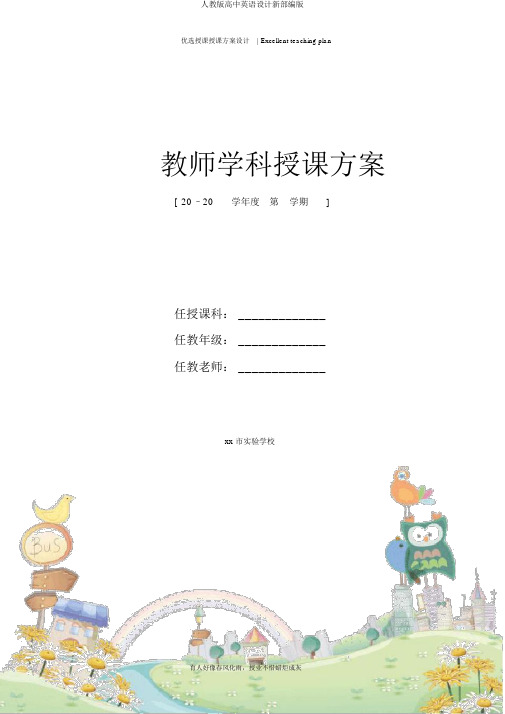
优选授课授课方案设计| Excellent teaching plan教师学科授课方案[ 20–20学年度第__学期]任授课科: _____________任教年级: _____________任教老师: _____________xx市实验学校优选授课授课方案设计| Excellent teaching plan人教版高中英语授课方案人教版高中英语必修 5 Unit 2 The United Kingdom一.授课内容解析:人教版新课标高中英语必修 5 第二单元 (The United Kingdom ) Using language Sightseeing in London让学生认识英国国都伦敦的名胜古迹 ( BigBen;StPaul ’ sCathedral ;WestminsterAbbey;Greenwich;Highgate Cemetery)二、授课目的 (Teaching goals)1.目口号言( Target Language)a.重点词汇和短语sightseeing, available, delight, tower, royal, uniform, splendid, statue, communism, thrillb.重点句式It seemed strange that the man who had developed communism should have lived and died in London. P14But she was thrilled by ... P142. 能力目标( Ability goals )Improve the reading ability of the students and enable the students to plan atour around certain places.3. 学能目标 Learning ability goalsHelp the students know more about the historical sites in London.三、授课重难点( Teaching important & difficult points)Help the students identify different kinds of tour and talk about the most interesting place for the tour and master the key words and expressions in the passage.四、授课方法( Teaching methods )1、任务型授课法( Task-based teaching method)。
高中英语新课标优秀教案

高中英语新课标优秀教案一、教学内容本节课选自高中英语教材第二章第五节《英语时态的应用》。
详细内容包括一般现在时、一般过去时、一般将来时、现在进行时、过去进行时、现在完成时、过去完成时等七大时态的基本概念、用法及转换规则。
二、教学目标1. 让学生掌握七大英语时态的基本概念及用法,提高语言表达能力。
2. 培养学生运用不同时态进行句子转换的能力,提高语法水平。
3. 激发学生学习英语的兴趣,培养合作学习、主动探究的良好习惯。
三、教学难点与重点教学难点:一般将来时、现在完成时、过去完成时的用法及句子转换。
教学重点:七大时态的基本概念、用法及转换规则。
四、教具与学具准备1. 教具:多媒体教学设备、PPT课件、黑板、粉笔。
2. 学具:英语课本、练习本、文具。
五、教学过程1. 导入:通过播放一段关于时间变化的短视频,引导学生关注不同时间背景下动词的变化,从而引出本节课的主题——时态。
2. 讲解:详细讲解七大时态的基本概念、用法及转换规则,结合实际例子,让学生更好地理解。
3. 例题讲解:针对每个时态,给出典型例题,引导学生运用所学知识进行分析。
4. 随堂练习:布置相关练习题,让学生独立完成,巩固所学知识。
5. 小组讨论:将学生分成小组,讨论各时态在实际语境中的应用,提高语言运用能力。
7. 作业布置:布置课后作业,要求学生完成相关练习。
六、板书设计1. 英语时态的应用2. 内容:一般现在时、一般过去时、一般将来时现在进行时、过去进行时现在完成时、过去完成时各时态的用法及转换规则七、作业设计1. 作业题目:(1)请用一般现在时描述你的日常作息。
(2)请用一般过去时描述你昨天做了什么。
(3)请用一般将来时描述你明天的计划。
(4)请用现在进行时描述你正在做什么。
(5)请用过去进行时描述昨天你在做什么。
(6)请用现在完成时描述你已经完成的任务。
(7)请用过去完成时描述昨天之前已经完成的任务。
2. 答案:(1)I get up at 6:00 a.m. every day and go to schoolat 7:00 a.m.(2)Yesterday, I went to the library and read some books.(3)Tomorrow, I will go to the zoo with my friends.(4)I am studying for the English test.(5)Yesterday, I was watching TV when my friendcalled me.(6)I have finished my homework.八、课后反思及拓展延伸1. 课后反思:本节课通过实践情景引入、例题讲解、随堂练习等多种教学手段,让学生掌握了七大时态的基本概念、用法及转换规则。
2024更新版高中英语教育新课程标准教育部部编版
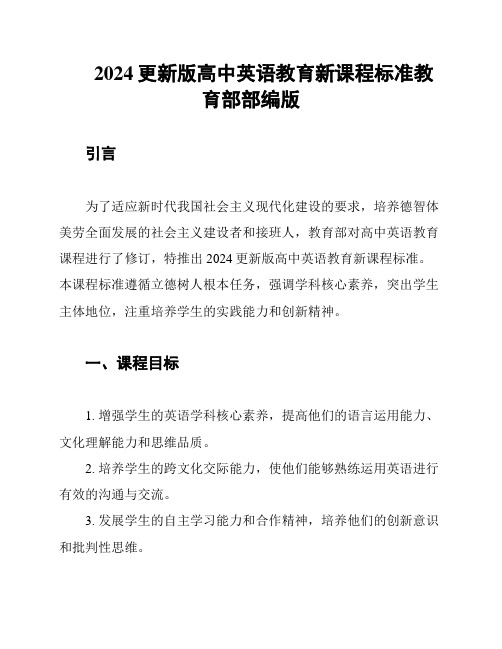
2024更新版高中英语教育新课程标准教育部部编版引言为了适应新时代我国社会主义现代化建设的要求,培养德智体美劳全面发展的社会主义建设者和接班人,教育部对高中英语教育课程进行了修订,特推出2024更新版高中英语教育新课程标准。
本课程标准遵循立德树人根本任务,强调学科核心素养,突出学生主体地位,注重培养学生的实践能力和创新精神。
一、课程目标1. 增强学生的英语学科核心素养,提高他们的语言运用能力、文化理解能力和思维品质。
2. 培养学生的跨文化交际能力,使他们能够熟练运用英语进行有效的沟通与交流。
3. 发展学生的自主学习能力和合作精神,培养他们的创新意识和批判性思维。
4. 帮助学生了解世界多元文化,拓宽国际视野,增强民族自豪感和文化自信心。
二、课程内容1. 语言知识:包括语音、词汇、语法、功能项目和话题等,注重培养学生的语言运用能力。
2. 文化背景:涵盖英语国家的文化、历史、社会等方面的知识,帮助学生理解西方文化,提高跨文化交际能力。
3. 技能训练:听说读写四大技能的综合训练,以及相应的策略运用,提高学生的语言实际运用能力。
4. 任务型教学:通过完成各种真实的任务,培养学生的实践能力和创新精神,使他们在实践中学会学习、学会合作、学会生存。
三、课程实施1. 教学方法:采用任务型教学、合作学习和探究学习等方法,充分发挥学生的主体作用。
2. 教学手段:充分利用多媒体、网络等现代教育技术手段,提高教学效果和学生的学习兴趣。
3. 评价方式:注重形成性评价和终结性评价相结合,全面、多元地评价学生的学科核心素养。
4. 课程资源:开发和利用各种课程资源,丰富教学内容,提高学生的学习体验。
四、课程安排1. 课时安排:高中英语课程每周安排3-4课时,共计240课时。
2. 课程结构:分为必修课程、选择性必修课程和选修课程,满足不同学生的学习需求。
3. 学段安排:分为三个学段,每个学段40课时,每个学段结束后进行阶段性评价。
高中英语新课标教学设计
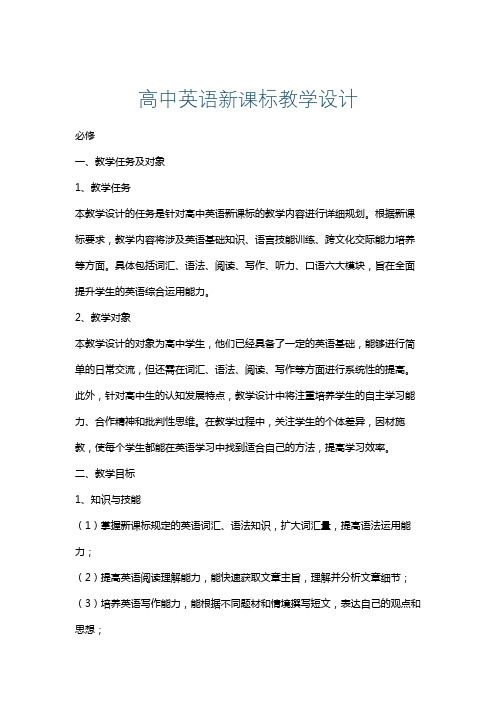
高中英语新课标教学设计必修一、教学任务及对象1、教学任务本教学设计的任务是针对高中英语新课标的教学内容进行详细规划。
根据新课标要求,教学内容将涉及英语基础知识、语言技能训练、跨文化交际能力培养等方面。
具体包括词汇、语法、阅读、写作、听力、口语六大模块,旨在全面提升学生的英语综合运用能力。
2、教学对象本教学设计的对象为高中学生,他们已经具备了一定的英语基础,能够进行简单的日常交流,但还需在词汇、语法、阅读、写作等方面进行系统性的提高。
此外,针对高中生的认知发展特点,教学设计中将注重培养学生的自主学习能力、合作精神和批判性思维。
在教学过程中,关注学生的个体差异,因材施教,使每个学生都能在英语学习中找到适合自己的方法,提高学习效率。
二、教学目标1、知识与技能(1)掌握新课标规定的英语词汇、语法知识,扩大词汇量,提高语法运用能力;(2)提高英语阅读理解能力,能快速获取文章主旨,理解并分析文章细节;(3)培养英语写作能力,能根据不同题材和情境撰写短文,表达自己的观点和思想;(4)增强英语听力水平,能理解日常生活中的英语对话和独白,提高获取信息的能力;(5)提升英语口语表达能力,能在课堂上进行流利、准确的口语交流,增强实际运用能力。
2、过程与方法(1)采用任务型教学法,引导学生通过完成具体任务,在实践中学习英语知识;(2)运用情景教学法,创设真实的语境,让学生在情境中体验和运用英语;(3)鼓励学生参与课堂讨论,培养合作学习意识,提高解决问题的能力;(4)引入多媒体教学资源,丰富教学手段,提高学生的学习兴趣和积极性;(5)实施个性化教学,关注学生的兴趣和特长,激发学生的学习潜能。
3、情感,态度与价值观(1)培养学生对英语学习的兴趣和热情,使其树立自信心,形成积极的学习态度;(2)引导学生认识到英语学习的重要性,激发学生的内在学习动机;(3)通过英语学习,培养学生的跨文化交际意识,使其尊重并理解不同的文化背景;(4)教育学生遵守英语学习的道德规范,遵循合作、互助、诚信的原则;(5)培养学生具备全球视野,关注国际事务,提高其作为世界公民的素养。
《2023年高中英语新课程标准》精品教案人教版

《2023年高中英语新课程标准》精品教案人教版一、教学内容根据《2023年高中英语新课程标准》,本节课我将为学生们讲授人教版高中英语教材第二册第七单元“Films and Film Events”内容。
具体包括:Section A中听力练习、阅读理解以及相关词汇和语法点;Section B中对话和阅读篇章,重点讲解与电影相关词汇和表达方式。
二、教学目标1. 让学生掌握本节课生词和短语,并能熟练运用到实际语境中。
2. 培养学生英语听力、阅读和口语表达能力,提高他们英语综合素质。
3. 引导学生解电影艺术,培养他们审美情趣。
三、教学难点与重点1. 教学难点:电影相关词汇和表达方式理解与运用,以及听力材料理解和口语表达。
2. 教学重点:Section A中听力练习、阅读理解和Section B中对话、阅读篇章。
四、教具与学具准备1. 教具:多媒体设备、投影仪、黑板、粉笔。
2. 学具:教材、听力材料、练习本、笔。
五、教学过程1. 导入:通过播放一段电影预告片,激发学生对电影话题兴趣,引入本节课主题。
2. 新课内容展示:(1)展示Section A生词和短语,让学生跟读并模仿。
(2)播放听力材料,引导学生完成相关练习。
(3)讲解阅读篇章,让学生理解电影评论基本框架和表达方式。
3. 例题讲解:针对本节课重点和难点,进行详细讲解和示范。
4. 随堂练习:让学生完成教材上相关练习,巩固所学知识。
5. 口语练习:组织学生进行小组讨论,讨论他们喜欢电影类型和电影明星,提高口语表达能力。
六、板书设计1. Films and Film Events2. 主要内容:(1)生词和短语(2)听力练习答案(3)阅读篇章框架七、作业设计1. 作业题目:(1)完成教材上练习题。
(2)以“我最爱电影”为主题,写一篇英语短文,不少于100词。
2. 答案:课后统一发放。
八、课后反思及拓展延伸1. 反思:针对本节课教学过程和学生掌握程度,反思教学方法有效性,调整教学策略。
新课标高中英语1必修全册教案

新课标高中英语1必修全册教案一、教学内容1. Unit 1 My First Day at Senior High详细内容:描述了学生在高中的第一天,通过对话和阅读了解校园生活。
2. Unit 2 My New Teachers详细内容:介绍了几位不同风格的老师,学习如何描述人物特点。
二、教学目标1. 掌握本单元的重点词汇和短语,并能灵活运用到实际情景中。
2. 提高学生的听说读写能力,尤其是描述人物和事件的能力。
3. 培养学生学会尊重和理解不同的教学风格,增强团队合作意识。
三、教学难点与重点1. 教学难点:描述人物特点的词汇和句型,以及如何运用到实际情景中。
2. 教学重点:听说读写技能的培养,尤其是口语表达能力的提高。
四、教具与学具准备1. 教具:多媒体设备、PPT、黑板、录音机、卡片等。
2. 学具:课本、练习本、字典、笔等。
五、教学过程1. 导入:通过展示一组学生在高中第一天的照片,引发学生讨论,导入新课。
2. 新课内容展示:讲解Unit 1 My First Day at Senior High 的重点词汇和句型,进行角色扮演活动。
3. 例题讲解:针对Unit 2 My New Teachers,讲解如何描述人物特点,给出示例。
4. 随堂练习:让学生运用所学知识,描述自己的老师,进行小组讨论。
5. 口语练习:模拟情景,让学生进行对话练习,提高口语表达能力。
六、板书设计1. Unit 1 My First Day at Senior High重点词汇:nervous, excited, confused, helpful, friendly等。
重点句型:I felt when; The teacher is and he/she等。
2. Unit 2 My New Teachers描述人物特点的词汇:strict, patient, humorous, knowledgeable等。
描述人物特点的句型:My teacher is; He/She always等。
【新教材】人教版高中英语必修第二册全册精编教案设计.docx
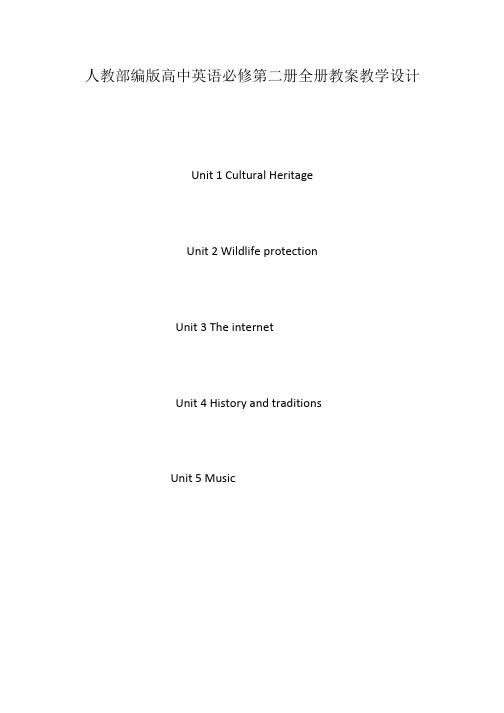
人教部编版高中英语必修第二册全册教案教学设计Unit 1 Cultural HeritageUnit 2 Wildlife protectionUnit 3 The internetUnit 4 History and traditionsUnit 5 MusicUnit 1 Cultural HeritagePeriod 2 Reading and Thinking:From Problems to Solutions【教材分析】1.This section focuses on "Understanding how a problem was solved,,, which is aimed to guide students to analyze and discuss the challenges and problems faced by cultural heritage protection during the construction of Aswan Dam, as well as the solutions. On the basis of understanding, students should pay attention to the key role of international cooperation in solving problems, and attach importance to the balance and coordination between cultural heritage protection and social and economic development. Students are encouraged to face challenges actively, be good at cooperation, and make continuous efforts to find reasonable ways and means to solve problems.【教学目标】1.Enable students to understand the main information and text structure of the reading text;2.Motivate students to use the reading strategy "make a timeline,, according to the appropriate text genre;3.Enable students to understand how a problem was solved;4.Enable students to understand the value of protecting cultural heritage by teamwork and global community;【教学重难点】1.Guide students to pay attention to reading strategies, such as prediction, self-questioning and scanning.2.Help students sort out the topic language about protecting cultural relics and understand the narrative characteristics of "time-event" in illustrative style3.Lead students to understand the value of protecting cultural heritage by teamwork and global community;【教学过程】1.PredictionStep 1 Predicting the main idea of the passageLook at the title and the pictures, and then predict what the passage will be about.Q: What will be talked about?Step 2: Fast reading tasksTask of the first fast reading:Read quickly and figure out the key words of each paragraph.•Paragraph 1: challenge•Paragraph 2: proposal led to protests•Paragraph 3: committee established•Paragraph 4: brought together•Paragraph 5: success•Paragraph 6: spiritTask of the second fast reading:1.Why did the Egyptian government want to build a new dam in the 1950s?2.Why did the building of the dam lead to protests?3.How did the government save the cultural relics?4.Which one can describe the project?A. Successful.B. Negative.C. Useless.D. Doubtful.5.What can be learned from the Aswan Dam project?Step 3: Careful reading tasksRead more carefully and answer the following questions.1.What do "problems" refer to and what do "solutions" refer to?2.Find out the numbers in paragraph four and explain why the author used exact numbers instead of expressions like many?3.What can you infer from "Over the next 20 years, thousands of engineers and workers rescued 22 temples and countless cultural relics"?4.What can you infer from "Fifty countries donated nearly 80 million to the project"?The project cost a lot of money.5.Before the building of the dam, what problems did the Nile River bring to the Egyptian?6.What words can you think of to describe the working process of the project?Step 4: ConsolidationDivide the passage into three parts and get the main idea of each part.Part 1 (Paragraph 1)The introduction of the topicKeeping the right balance between progress and the protection of cultural sites is a big challenge.Part 2 (Paragraphs 2-5)The process of saving cultural relics•Big challenges can sometimes lead to great solutions.•The Egyptian government wanted to build a new dam, which would damage many cultural relics.•The government turned to the UN for help.•Experts made a proposal for how to save cultural relics after a lot of efforts and the work began.•Cultural relics were taken down and moved to a safe place.•Countless c ultural relics were rescued.•The project was a success.Part 3 (Paragraph 6)The summary of the textThe global community can sometimes provide a solution to a difficult problem for a single nation.Step 5: Critical thinking:1.How to deal with the construction and the protection of cultural relics?2.As students, what should we do to protect our cultural relics?Step 6: summaryStep 7 Homework:Review what we have learned and find out the key language points in the text. 板书设计教学反思Unit 2 Wildlife ProtectionReading for Writing【教材分析】The activity theme is "making effective poster,,. The protection of wildlife needs the participation of the whole society. It is imperative to educate the public on wildlife protection and arouse the public's awareness and enthusiasm for wildlife protection. Teenagers are not only the main body of education, but also the "ambassador" of publicity and promotion. To make posters, students need to understand and study the situation of endangered animals and think about protection measures. In the process of reading and understanding the content of posters and making posters, students should be trained to master and use the style of posters, and their social responsibility and sense of responsibility should be cultivated.The reading text is two posters. The first poster, "give ugly a chance!" calls on people to protect all kinds of wild animals and not treat them differently because of personal likes and dislikes. No matter how beautiful or ugly animals are, they have the meaning and value of existence. The world is beautiful because of the diversity of biology. The article uses the tone of statement to make people unconsciously accept the author's point of view. The second POSTER "don't make paper with my home!,, adopts anthropomorphic rhetoric and takes koala's heart cry as the title, criticizing those behaviors of deforestation and destruction of animal homes. The text is a progressive explanation of the title. Exclamatory sentences and rhetorical sentences are used in this paper, which express the author's attitude and point of view. In addition, the title ofthese two posters uses exclamation sentences with strong appeal and emotional color, coupled with vivid pictures, making the posters more powerful.【教学目标】1.Cultivate students to acquire some features about an English poster by reading the text.2.Help students to write an English poster about animal protection properly using some newly acquired writing skills in this period.3.Develop students' writing and cooperating abilities.4.Strengthen students' great interest in writing discourses.【教学重难点】1.Stimulate students to have a good understanding of how to write an English poster properly.2.Cultivate students to write an English poster properly and concisely.【教学过程】Step 1: Lead inDo you want to be a volunteer of a pefs shelter? Why?Yes, I want to be a volunteer of it, because I want to help the pets, which are lovely and cute. I like them very much.Step 2: Read to discover details concerning the main details of the news report.I.Read the news report and then solve the questions below.1.Who started the rescue centre called the Small Friends Pet Shelter?A group of high school students and parents.2.What did the young people do in the shelter?Take care of animals.3.How do the young people think of their work?Worthwhile4.What help does the centre need?Volunteers, time and love.II. Read the text again and then choose the best answer.1.What should we do when we protect the wildlife animals?A.Treat all the wild animals equally.B.Only pay attention to less cute animals.C.Pay attention to cute animals.D.Care about endangered wildlife animals.2.Whafs the bad effect of cutting down billions of trees to make paper for humans?A.Make a lot of animals homeless.B.Make a number of wildlife animals dying out.C.The animals5 habitat is being destroyed.D.All of them.【答案】ADCStep 3: Study the organization and language features.1.Read the passage more carefully and write down the outline of the text.1.The Small Friends Pet Shelter was started by a group of high school students and their parents when they started to see many pets (that were left behind after their families moved away).译文:当一些高中生和他们的父母看到在主人搬走后,时,们建立了小朋友宠物收容所。
新人教版高中英语必修一第一单元名师优秀教案新部编本
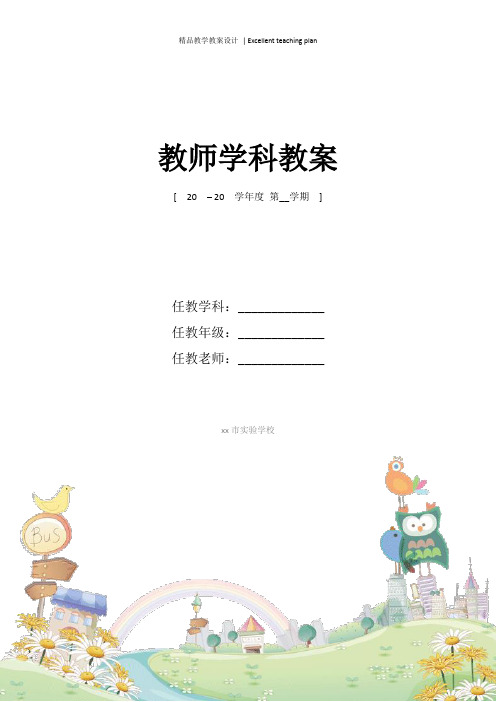
教师学科教案[ 20 – 20 学年度第__学期]任教学科:_____________任教年级:_____________任教老师:_____________xx市实验学校U nit one FriendshipTeaching aims:1.能力目标:a.Listening: get information and views from the listening material;b.Speaking: express one’s attitude or views about friends and friendship inappropriate words.c.Reading: enable the Ss to get the main idead.Writing: write some advice about making friend as an editor2.知识目标:a.Talk about friends and friendship; how to make friends; how to maintainfriendshipe the following expressions:I think so. / I don’t think so.I agree. / I don’t agree.That’s correct.Of course not.Exactly.I’m afraid not.c. to enable the Ss to control direct speech and indirect speechd. vocabulary: upset , calm , concern , loose, Netherlands, German, series, outdoors, dusk, crazy , purpose , thunder , entire, entirely, power , curtain, dusty, partner, settle, suffer , highway, recover, pack, suitcase, overcoat, teenager, exactly, disagree, grateful, dislike, tip , swap , itemadd up \ calm down\ have got to \be concerned about \ walk the dog \ go through \ set down \a series of \ on purpose \ in order to \ at dusk \ face to face \ no longer\not …any longer\ suffer from\ get\be tired of \ pack sth. up \ get along with \ fall in love \ join in3. 情感目标:a. To arose Ss’ interest in learning English;b. To encourage Ss to be active in the activities and make Ss to be confident;c. To develop the ability to cooperate with others.4. 策略目标:a. To develop Ss’ cognitive strategy: taking notes while listening;b. To develop Ss’ communicative strategies.5. 文化目标:to enable the Ss to get to know different opinions about making friends from different countries.Teaching steps:Period oneStep1. Warming up1. Ss listen to an English song AULD LANG SYNE.2. Brainstorming: let Ss say some words about friendship – honest, friendly, brave,humorous, funny, wise, kind, open-minded, responsible, helpful….Step 2. Talk about your old friends1.Ss talk about their old friends in Junior Middle School, talk about theirappearance, personality, hobbies, etc.2.Self-introductionStep 3. Make new friends1.Ss go around and ask their new friends some information and fill in the followingStep 4. Do a surveySs do the survey in the text ,P1Sep 5. Listening and talkingDo Wb P41 (Talking). While Ss listen to the material, ask them to take notes about the speaker’s views of making friends.When Ss make their conversation, ask them to try to use the following expressions.I think so. / I don’t think so. I agree. / I don’t agree.That’s correct. Of course not. Exactly. I’m afraid not.Step 6. DiscussionDivide Ss four in one group and each group choose a topic to discuss. There are four topics.Topic 1: Why do you need friends? Make a list of reasons why friends are important to you.Topic 2: There is a saying “to have a good friend, you need to be a good friend.” What do you think of the saying and how can you be a good friend?Topic 3: Does a friend always have to be a person? What else can be your friend? Why?Topic 4: List some qualities of a person who does not make friend easily.Step 7. Summary1.Ask Ss themselves to summarize what is friendship and what is the mostimportant in making friends.2.T shows more information about friendship and a poem about friendship.What is friendship?I want to find the answer to the questionWhat is friendship?When it rains, I think friendship is a small umbrella.It can give me a piece of clear sky.When I’m crying, I think friendship is a white handkerchief.It can wipe my tears dry.When I am sad, I think friendship is a warm word.It can bring me happiness again.When I am in trouble, I think friendship is a strong hand.It can help me escape my troubles.When I sit in a quiet place, I think friendship is a very wonderful feeling.It can’t be pulled and torn, because it is in everyone’s heart.It is there from the beginning to the end of our lives.3. Tell Ss: make new friends and keep the old; one is silver and the other is gold. Step 8. Evaluation1.Look up the new words and expressions in warming up and pre-reading in adictionary.2.Write a short passage about your best friend.Period twoStep1.Warming upActivity1: Suppose you have to stay indoors to hide yourself for a whole year. You can never go outdoors, otherwise you will be killed. You have no telephone, computer, or TV at home.How would you feel?What would you do?Four students a group discuss with each other for 2 minutes.Activity2: Play a short part of the movies Schindler’s ListStep2. PredictingStudents read the title of the passage and observe the pictures and the outline of it to guess:Who is Anne’s best friend?What will happen in the passage?Students skim the passage in 2 minutes to get the main idea :Who is Anne’s best friend?When did the story happen?Step4. ScanningStudents work in pairs to find the information required below:Annein World War ⅡStep5. Intensive readingStudents work in group of four to discuss the following open questions:1.Why did the windows stay closed?2.How did Anne feel?3.What do you think of Anne?4.Guess the meanings of “spellbound”, “ hold me entirely in their power” from thediscourse(语篇,上下文).5.Which sentences attract you in the passage?Step6. ActivityFour students a group to discuss the situation:Suppose you four have to hide yourselves for 3 months. During the three months,you will be offered the basic food, water and clothes. Your group can take 5 thingswith you.What will you take? Why?How will you spend the 3 months?How will you treat each other and make friends ?Step7.AssignmentTask1.Surf the internet to find Anne’s Diary and read some of it. Print out apiece of the diary and write down your feelings after reading it on the page. Wewill share the pieces and your feelings with the whole class.Task2.Ex2、3 、4on Page3Period threeCheck the Ss’ assignment: task 2Step 2. Language points:1.add (v.)1). To put together with something else so as to increase the number, size, importance, etc.增加,添加Please add something to what I’ve said, John.2). To join numbers, amount, etc so as to find the total 相加Add up these figures for me, please.add to something: to increase 增加What he did has added to out difficulties.add up to: to amount to 加起来等于;总计The cost added up to 100 million yuan.2. go through1). To examine carefully 仔细阅读或研究I went through the students’ papers last night.2). To experience 经历,遭受或忍受You really don’t know what we went through while working on this project.3. crazy (adj.)1). mad, foolish 疯狂的,愚蠢的It’s crazy to go out in such hot weather.2). wildly excited; very interested 狂热的,着迷的She is crazy about dancing.4. be concerned about/for: be worried about 担心We’re all concerned about her safety.Step 3. Learning about language1.Finish Ex.1, 2 and 3. on Page 4.2.Direct speech and indirect speech: Ss do Ex.1 and 2 on Page 5. Then let the Ssthemselves discover the structures.Step 4. PracticeUsing structures on Page 42: ask the Ss to use indirect speech to retell the story. Step 5. AssignmentFinish Wb. Ex, 1 and2 on page 41 and 42.Period fourStep 1. RevisionCheck the Ss’ assignment.Step 2. R eadingSs read the letter on page 6Notes:1.get along with2.fall in loveStep 3. ListeningSs should take notes while they are listening.1. first listening: Ss listen and answer the questions of part 2 on page 6.2. second listening: Ss listen again and finish part 3 on page 6.Step 4. ListeningSs listen to a story about Anne and try to finish Wb. Ex 1 and 2 on page 43 and page 44.Step 5. SpeakingSs work in groups of four. Design a questionnaire to find out what kind of friends your classmates are. They can use the quiz in the Warming up to help them.Step 6. Assignment1. Ss prepare the reading task on page 44.2. Surf the internet and find some material about friendship in different countries.Period fiveStep 1. Warming upSs say something about making friends and how to maintain friendship.Step 2. ListeningSs listen to a short passage and fill in the blanks on page 41 (listening).Step 3. Reading1.first reading: Ss read the passage about friendship in Hawaii and finishWb.Ex1.on page 44.2.second reading: Ss read again and discuss the questions on page 44.3.Ss share their material about friendship in different countries in groups, and thenchoose some groups to show theirs in class.Step 4. assignmentSs collect some proverbs about friendship.Period sixStep 1. Pre-writing1.Read a letter from a student called Xiaodong.2.Go over the advice on page 7 and be ready for writing.Step 2. While-writingAsk the Ss to write a letter to Xiaodong as an editor and give him some advice.1.Ss make a list about the important information that they need.2.Ss begin to write the letter to Xiaodong.3.Ss revise their letters by themselves.4.Ss exchange their writing paper with their partners and correct the mistakes.(tense, spelling, letters, structures….)5.Ss get back their own writing paper and write the letter again.Step 3. Post-writingChoose some students’ writing paper and show in the class. Ask the Ss to correct the mistakes together and also learn from some good writings.Step 4. Writing for fun1.Ss read the passage on page 7 by themselves.2.Ss try to write a few lines to describe their best friends or a person they know.3.Show some Ss’ writings in class.Step 5.AssignmentDo Wb writing task on page 46.Period sevenTeachers can use this period freely.Suggestion: Teachers can use this period to let Ss sum up what they have learned and explain what Ss couldn’t understand very well in this unit. Teachers can also add more practice in this period to consolidate what the Ss have learned. Finally, ask the Ss to finish checking yourself on page 47. It is very important to improve their learning.。
《2023年高中英语新课程标准》教案人教版

《2023年高中英语新课程标准》教案人教版一、教学内容本节课我们将学习《2023年高中英语新课程标准》人教版第四单元“生活与科学”的第一章节。
详细内容包括:1. 掌握与生活科学相关的词汇和表达方式;2. 运用一般现在时描述科学现象;3. 学会阅读和理解科学短文。
二、教学目标1. 能够正确运用与生活科学相关的词汇进行交流。
2. 运用一般现在时描述科学现象,提高语言运用能力。
3. 提高阅读理解能力,了解科学知识。
三、教学难点与重点教学难点:一般现在时态的运用,科学短文的阅读理解。
教学重点:与生活科学相关的词汇和表达方式,一般现在时态的描述。
四、教具与学具准备教具:PPT,教学视频,实物展示。
学具:学生用书,练习册,文具。
五、教学过程1. 导入:通过展示日常生活中的科学现象,引起学生对本节课的兴趣。
2. 新课内容:讲解与生活科学相关的词汇和表达方式,引导学生运用一般现在时描述科学现象。
a. 展示词汇,让学生跟读、拼写。
b. 举例说明一般现在时的用法,让学生模仿造句。
c. 分析科学短文,教授阅读技巧。
3. 例题讲解:针对一般现在时和科学短文阅读进行讲解,让学生掌握解题方法。
4. 随堂练习:设置相关练习,巩固所学知识。
5. 小组讨论:让学生分组讨论生活中的科学现象,并用英语进行描述。
六、板书设计1. 《2023年高中英语新课程标准》人教版第四单元“生活与科学”2. 主要词汇和表达方式:生活科学词汇:technology, innovation, discovery, experiment, research一般现在时态:subject + verb (s/es) + object3. 科学短文阅读技巧:略七、作业设计1. 作业题目:a. 用一般现在时描述生活中的一个科学现象。
b. 阅读一篇科学短文,回答相关问题。
2. 答案:b. 根据短文内容回答。
八、课后反思及拓展延伸2. 拓展延伸:鼓励学生在课后观察生活中的科学现象,用英语进行描述,并分享给同学。
2023学年部编版高中英语新教材必修(上)第三单元教学设计

2023学年部编版高中英语新教材必修(上)第三单元教学设计一、单元概述1.1 单元主题本单元主题为“Festivals and customs”,主要介绍世界各地的节日和习俗。
通过学习本单元,学生能够了解不同文化背景下的节日庆祝方式,提高跨文化交际能力。
1.2 单元目标本单元旨在帮助学生:- 掌握相关词汇和表达方式;- 能够运用一般现在时和一般过去时描述节日和习俗;- 提高听力、口语、阅读和写作能力;- 增强对文化差异的敏感性。
二、教学内容2.1 教学材料- 教材:部编版高中英语新教材必修(上);- 辅助材料:多媒体课件、网络资源、相关阅读材料。
2.2 教学内容安排- Lesson 1:节日和习俗的介绍;- Lesson 2:听力练习和文化背景知识拓展;- Lesson 3:口语表达和角色扮演;- Lesson 4:阅读理解;- Lesson 5:写作练习。
三、教学方法3.1 任务型教学法通过设计各种任务,让学生在实际语境中运用所学知识,提高语言运用能力。
3.2 交际型教学法鼓励学生积极参与课堂讨论,培养学生的跨文化交际能力。
3.3 合作学习将学生分组,进行小组讨论和合作完成任务,提高学生的团队协作能力。
四、教学评估4.1 课堂参与度观察学生在课堂上的参与情况,包括发言、讨论、角色扮演等。
4.2 作业完成情况评估学生完成作业的质量,包括词汇、语法、听力、阅读和写作等方面。
4.3 单元测试进行单元测试,全面评估学生的学习效果。
五、教学进度安排5.1 课时安排本单元共计5课时。
5.2 进度安排- 第1周:Lesson 1;- 第2周:Lesson 2;- 第3周:Lesson 3;- 第4周:Lesson 4;- 第5周:Lesson 5、单元总结和测试。
六、教学资源- 多媒体课件;- 网络资源;- 相关阅读材料;- 录音设备;- 测试卷。
七、教学建议- 注重文化背景知识的传授,提高学生的跨文化交际能力;- 鼓励学生主动参与课堂讨论,培养学生的自主学习能力;- 针对不同学生的学习水平,适当调整教学难度,确保教学质量。
新教材高中英语教案模板

教学目标:1. 知识与技能:培养学生阅读理解能力,提高学生的词汇量和语法知识。
2. 过程与方法:通过阅读实践活动,培养学生自主学习、合作学习和探究学习的能力。
3. 情感态度与价值观:激发学生对英语学习的兴趣,培养学生的跨文化交际意识。
教学重点:1. 阅读理解策略的应用。
2. 词汇和语法知识的掌握。
教学难点:1. 阅读速度和理解能力的提高。
2. 词汇和语法知识的灵活运用。
教学准备:1. 教学课件或教材。
2. 阅读材料。
3. 录音设备。
教学过程:一、导入1. 利用图片、视频或音乐等激发学生的兴趣,引入话题。
2. 复习上节课所学内容,为新课做铺垫。
二、新课导入1. 阅读课文,引导学生了解文章大意。
2. 提出问题,让学生带着问题阅读课文,培养学生的阅读策略。
三、词汇教学1. 引导学生关注课文中的生词,通过多种方式帮助学生理解和记忆。
2. 结合语境,讲解词汇的用法和搭配。
四、语法教学1. 分析课文中的语法结构,讲解语法规则。
2. 通过练习题,让学生巩固所学语法知识。
五、阅读理解1. 分组讨论,让学生分享阅读心得。
2. 针对课文内容,设置阅读理解题,让学生在答题过程中提高阅读能力。
六、课堂小结1. 总结本节课所学内容,强调重点和难点。
2. 鼓励学生在课后进行复习和巩固。
七、布置作业1. 完成课后练习题,巩固所学知识。
2. 预习下一节课的内容。
教学反思:1. 教学过程中,关注学生的个体差异,因材施教。
2. 创设轻松、愉快的课堂氛围,激发学生的学习兴趣。
3. 鼓励学生积极参与课堂活动,培养学生的自主学习能力。
4. 及时反馈学生的学习情况,调整教学策略,提高教学效果。
教学评价:1. 课堂参与度:观察学生在课堂上的表现,评价其参与程度。
2. 阅读理解能力:通过阅读理解题,评价学生的阅读能力。
3. 词汇和语法知识:通过课后练习题,评价学生的词汇和语法掌握情况。
备注:本教案仅供参考,教师可根据实际情况进行调整。
高中英语新课标优秀教案

2.文化背景的理解
-在教学中,教师应适时引入相关的文化背景知识,让学生了解中西方文化差异,提高学生的跨文化交际意识。
-通过讲解日常口语表达背后的文化内涵,使学生更好地理解并运用这些表达。
-鼓励学生在课后多阅读英语文章、观看英文影视作品,了解不同文化背景下的交流方式和习俗。
四、教具与学具准备
1.教具:多媒体设备、PPT、黑板、录音机。
2.学具:英语课本、笔记本、字典、口语练习材料。
五、教学过程
1.导入:通过播放一段关于日常交流的视频,让学生了解本节课的主题,激发学生的学习兴趣。
2.新课内容展示:详细讲解教材中的对话、阅读、词汇及语法点。
a.对话:引导学生分析对话中的口语表达,并让学生模仿练习。
2.教学过程:实践情景引入、例题讲解、随堂练习。
3.作业设计:根据本节课所学内容编写对话,运用口语表达。
一、教学难点解析
1.口语表达的灵活运用
-在课堂教学中,教师应注重培养学生的口语表达能力。通过设置不同场景,让学生进行角色扮演,模拟实际交流,以提高学生口语表达的灵活性和准确性。
-教师应关注学生的发音、语调、语速等方面,纠正学生的错误,指导学生运用正确的语音语调进行交流。
四、情景导入
1.创设生动、贴近生活的情景,让学生在真实语境中学习英语,提高学习兴趣。
2.通过视频、图片等教学资源,引导学生进入情景,激发学生的学习热情。
教案反思
一、教学内容
1.反思本节课的教学内容是否充实、有趣,是否符合学生的实际需求。
2.调整教学内容,使之更具挑战性和实践性,提高学生的学习兴趣。
二、教学方法
2.答案:提供参考答案,供学生参考。
高中英语教学设计新部编版1

教师学科教案[ 20 – 20 学年度第__学期]
任教学科:_____________
任教年级:_____________
任教老师:_____________
xx市实验学校
高中英语教学设计
黎城一中孟环清
教学过程设计
Blackboard design (板书设计)
Reflection after teaching(教学反思)本节课我通过不同的任务设置,让学生在小组活动中通过合作和探究来完成各个任务,活动既有轻松有趣的自主学习环节,又有需要深层思考的阅读理解活动和讨论活动。
不同的任务设置激发了学生的学习兴趣和用英语表达的欲望,小
组活动在竞赛中进行,使得小组活动既有合作又有竞争,增加了小组活动的有效性。
在自主学习和合作探究的学习过程,学生获得了成就感,增强了自信心,同时也培养合作精神。
由于学生的语言基础不扎实,在表达自己的看法和用英语进行讨论时,不时有学生夹杂着汉语,或有的学生不敢大胆说出自己的看法,欲言又止。
这说明,在平时的教学中,我应该多呈现给学生更多的常用句型,让学生掌握常用句型,在让学生进行谈论前,应尽量帮助学生解决语言困难。
在学生进行小组活动时,应尽量给学生更多的帮助,主动了解学生的语言困难。
2024最新高中英语新课程标准教育部部编版英文版

2024最新高中英语新课程标准教育部部编版英文版2024 New High School English Curriculum Standard Ministry of Education CompilationIn 2024, the Ministry of Education will implement a new high school English curriculum standard. This updated curriculum aims to enhance students' language skills and overall proficiency in English. The curriculum will focus on integrating various language components, such as reading, writing, listening, and speaking, to provide a comprehensive learning experience for students.The new curriculum will also incorporate modern teaching methodologies and resources to engage students effectively. It will emphasize practical language usage and real-life communication scenarios to help students apply their English skills in a practical context. Additionally, the curriculum will align with global English language standards to ensure that students are well-prepared for international communication and opportunities.Teachers will play a crucial role in implementing the new curriculum. They will be provided with training and support to facilitate effective teaching practices and student learning outcomes. The Ministry of Education will also provide updated teaching materials and resources to assist teachers in delivering the curriculum effectively.Overall, the 2024 new high school English curriculum standard by the Ministry of Education aims to elevate the quality of English education in high schools, equip students with essential language skills, and prepare them for future academic and professional endeavors.。
《2023年高中英语新课程标准》教案人教版
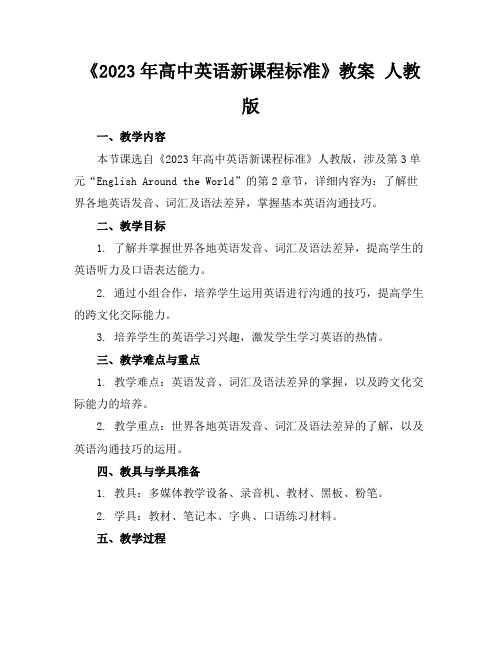
《2023年高中英语新课程标准》教案人教版一、教学内容本节课选自《2023年高中英语新课程标准》人教版,涉及第3单元“English Around the World”的第2章节,详细内容为:了解世界各地英语发音、词汇及语法差异,掌握基本英语沟通技巧。
二、教学目标1. 了解并掌握世界各地英语发音、词汇及语法差异,提高学生的英语听力及口语表达能力。
2. 通过小组合作,培养学生运用英语进行沟通的技巧,提高学生的跨文化交际能力。
3. 培养学生的英语学习兴趣,激发学生学习英语的热情。
三、教学难点与重点1. 教学难点:英语发音、词汇及语法差异的掌握,以及跨文化交际能力的培养。
2. 教学重点:世界各地英语发音、词汇及语法差异的了解,以及英语沟通技巧的运用。
四、教具与学具准备1. 教具:多媒体教学设备、录音机、教材、黑板、粉笔。
2. 学具:教材、笔记本、字典、口语练习材料。
五、教学过程1. 导入:通过播放一段关于世界各地英语发音差异的视频,引起学生对本节课的兴趣。
2. 讲解:详细讲解世界各地英语发音、词汇及语法差异,结合教材进行实例分析。
3. 实践:分组进行口语练习,让学生模拟真实场景,运用所学知识进行沟通。
4. 例题讲解:针对本节课的重点内容,选取典型例题进行讲解,帮助学生巩固所学知识。
5. 随堂练习:设计相关练习题,让学生在课堂上即时巩固所学知识。
六、板书设计1. English Around the World2. 内容:世界各地英语发音、词汇及语法差异基本英语沟通技巧七、作业设计1. 作业题目:场景:两个来自不同国家的人第一次见面,互相问候并介绍自己的国家。
2. 答案:A: Hi, my name is Li Hua. I'm from China. How about you?八、课后反思及拓展延伸1. 课后反思:关注学生的学习反馈,针对学生的疑问进行解答,调整教学方法,提高教学效果。
2. 拓展延伸:鼓励学生课后观看英语原版电影、纪录片等,了解不同国家的文化背景,提高跨文化交际能力。
新课标高中英语的优质教案设计精编版
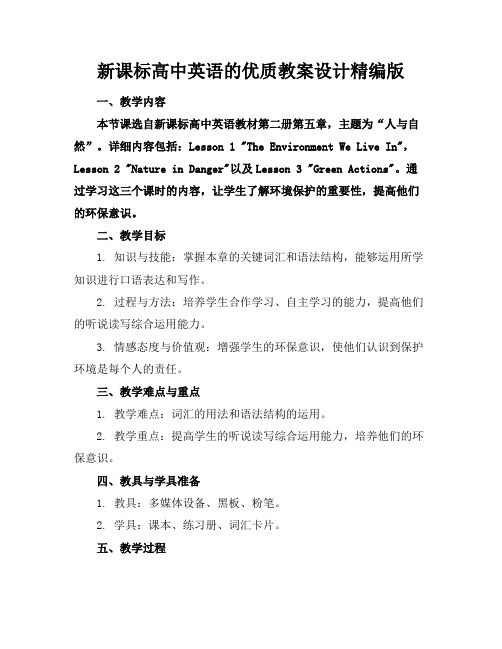
新课标高中英语的优质教案设计精编版一、教学内容本节课选自新课标高中英语教材第二册第五章,主题为“人与自然”。
详细内容包括:Lesson 1 "The Environment We Live In",Lesson 2 "Nature in Danger"以及Lesson 3 "Green Actions"。
通过学习这三个课时的内容,让学生了解环境保护的重要性,提高他们的环保意识。
二、教学目标1. 知识与技能:掌握本章的关键词汇和语法结构,能够运用所学知识进行口语表达和写作。
2. 过程与方法:培养学生合作学习、自主学习的能力,提高他们的听说读写综合运用能力。
3. 情感态度与价值观:增强学生的环保意识,使他们认识到保护环境是每个人的责任。
三、教学难点与重点1. 教学难点:词汇的用法和语法结构的运用。
2. 教学重点:提高学生的听说读写综合运用能力,培养他们的环保意识。
四、教具与学具准备1. 教具:多媒体设备、黑板、粉笔。
2. 学具:课本、练习册、词汇卡片。
五、教学过程1. 导入:通过展示环境污染的图片,引起学生对环保的关注,导入新课。
详细过程:播放图片,引导学生讨论环境污染问题,为新课的学习做好铺垫。
2. 新课内容展示与讲解:详细过程:讲解Lesson 1 "The Environment We Live In",引导学生学习词汇和语法,进行例句分析;接着讲解Lesson 2 "Nature in Danger",让学生了解自然环境的现状;讲解Lesson 3 "Green Actions",学习环保行动。
3. 实践情景引入:详细过程:分组讨论,每组设计一个环保宣传标语,并进行展示。
4. 例题讲解:详细过程:针对词汇和语法进行例题讲解,帮助学生巩固所学知识。
5. 随堂练习:详细过程:进行听说读写综合练习,检查学生对新课的掌握情况。
高中英语教学设计新部编版

教师学科教案[ 20 – 20 学年度第__学期]任教学科:_____________任教年级:_____________任教老师:_____________xx市实验学校高中英语教学设计教学过程设计Warming up(6 minutes) (热身,6分钟)(热身—Introductionsto talk about plants and animals that liveunder the sea. Have you seen plants andanimals that live under the sea ? Wheredid you see them ? What’s yourfavourite ? Share what you know aboutthe plants and animals under the sea..教师活动:老师问学生.Have you seenany plants and animals under the sea?Talk about them.学生活动:Talk about the plants andanimals that they have seen before.(海洋生物:whale dolphin sea starangle fish shark jelly fish coral andso学生的学习兴趣Enjoying pictures T:Ok, everyone. Let’s look at the pictures onthe screen and enjoy the beautiful seacreatures. (打开多媒体,展示图片)学生活动:Look at the pictures & talk aboutthe plants and animals they know.(把动植物名称和每幅图片连起来) 让学生欣赏美丽的海洋生物,帮助他们更多了解海洋生物从而培养他们热爱和保护海洋生物的意识。
- 1、下载文档前请自行甄别文档内容的完整性,平台不提供额外的编辑、内容补充、找答案等附加服务。
- 2、"仅部分预览"的文档,不可在线预览部分如存在完整性等问题,可反馈申请退款(可完整预览的文档不适用该条件!)。
- 3、如文档侵犯您的权益,请联系客服反馈,我们会尽快为您处理(人工客服工作时间:9:00-18:30)。
运用已知的关于北京交通方面的信息及学到的相关表达,解决实际生活中的问题——你正急于赶飞机却不知道如何安全快速地赶到机场,于是向周围的朋友求助,询问如何在两小时内能够以最佳线路到达机场。
八、板书设计
Module 2 Traffic Jam
Means of transport
Advantages
3).To improve the ability of getting information by reading and giving advice.
2. Process and method
1).To revise the means of transport by brainstorm.
2).To get the information by reading and listening.
2).To help Ss know more about the development of traffic in the big cities.
3).To develop Ss’ ability to give advice in a polite and proper way and helpothers.
3).To output their knowledge by speaking activities.
4).Student-centered and task-based teaching method
3. Emotion and attitude
1).To enrich students’ knowledge of different transportation vehicles
master the important words mentioned in the passage
Ask Ss to find the advantages and disadvantages of the five means mentioned in the text by reading the text again.
二、教学内容及模块整体分析
必修4第二模块的课文”Getting Around in Beijing”介绍了北京市北京公交系统以及相关的车辆情况,并引入了与交通和出行有关的词汇。通过学习该课文,学生在学习与交通有关的词汇和培养相关的语言技能的同时,将了解北京的交通状况,感受北京的交通问题。根据学生基础和认知情况把Introduction和Reading and Vocabulary整合为一个课时的教学内容。
2).How many buses and trolleybuses are there in Beijing?
3). Which is the best bus for tourists?
4). How many people can get in a minibus?
5).When does the underground close at night?
Students give their advice by discussing
The useful expressions:
You should ….I advice you to….
Make sure….
develop Ss’ ability to give advice in a polite and proper way and help others
help Ss know more about the development of traffic in the big cities.
Practice
.Competition of new words
Match the words in the box with their meanings.
(Rule: 1)Divide the Ss into three groups.2) One student has one chance .3) They can stand up to answer without handing up. )
教师学科教案
[20 – 20学年度第__学期]
任教学科:_____________
任教年级:_____________
任教老师:_____________
xx市实验学校
Module2课时二的教学设计
注:填写表格时,请您删除蓝色部分
课题:Getting Around in Beijing
科目
英语
教学对象
Pedicabs
explore the
narrow alleys
expensive
(回答正确的同学将获得有同学们亲手做的笑脸卡片)
Go through the meanings andmatch the words in the box with their meanings
Encourage the students to take an active part in the class
Listen to the passage by heart
Improve their listening ability
Fast-reading
1.Check their answers about the means mentioned in the passage.
2.Say who might find the information useful.
Ssgivethe means of transport as many as they can.
Develop the interest of this passage
revise the means of transport by brainstorm.
Listening
Ask Ss to listen to the passage, while listening, they should write down the means of transport mentioned in the passage. (Close their books)
output their knowledge by speaking activities
Discussion and homework
ask students’help
The topic is to
give my sister some advice on how to get toshanxiNo.1 Middle School from my hometown,shanxito find me and please give some reasons.
六、教学过程
教师活动
学生活动
设计意图
Lead-in
Showsome pictures of Beijing with a song called“北京欢迎你”
Brainstorm: ask Ss to show the means of transport as many as they can.
Enjoy some pictures of Beijing with a song called“北京欢迎你”.(sing in English)
Give students chances to speak
Suppose you havea chance to get around Beijing, what means of transport would you prefer to use to get around in Beijing? Why?(Work in pairs)
三、学情分析
高一386班学生基础普遍较差,但课堂气氛活跃,对学习英语有浓厚的兴趣,因此在授课过程中多采用师生互动形式。课堂活动环环相扣,遵循从易到难的原则。
四、教学策略选择与设计
Brain storm;task-based teaching;communicative teaching,individual work;pair work;group work .
6).What can you visit in a pedicab?
Students read the passage carefully to get more information
enrich students’ knowledge of different transportation vehicles
五、教学重点及难点
1.To master some words about traffic such as
2.To develop students’reading ability of skimming and scanning
3.How to make students fully understand the text
Group work to finish the table on the blackboard
Help students know about the transports bymakingcomparisons between different means of transportation
Hope they can know theimportance of team work
高一
课时
第二课时
提供者
单位
一、教学目标
1.Knowledge and skill
1).To master the important words mentioned in the passage.
2).To enable Ss to understand the meaning of the text.
